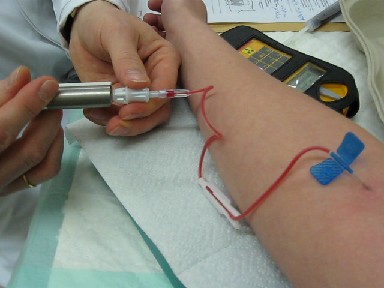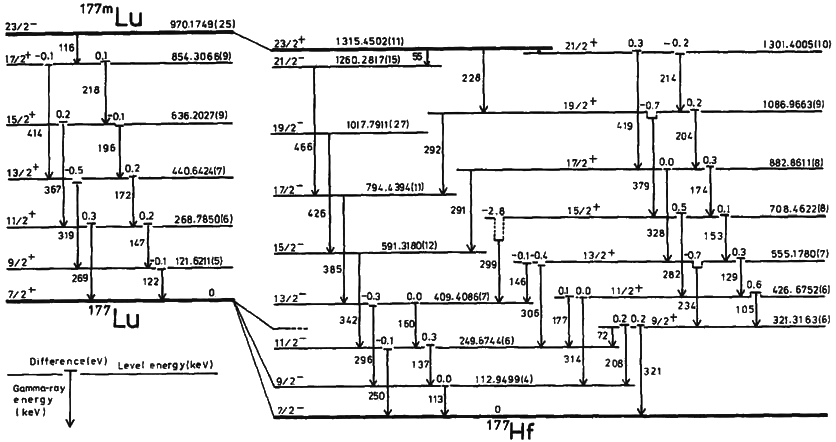|
99mTC
Technetium-99m (99mTc) is a metastable nuclear isomer of technetium-99 (itself an isotope of technetium), symbolized as 99mTc, that is used in tens of millions of medical diagnostic procedures annually, making it the most commonly used medical radioisotope in the world. Technetium-99m is used as a radioactive tracer and can be detected in the body by medical equipment (gamma cameras). It is well suited to the role, because it emits readily detectable gamma rays with a photon energy of 140 keV (these 8.8 pm photons are about the same wavelength as emitted by conventional X-ray diagnostic equipment) and its half-life for gamma emission is 6.0058 hours (meaning 93.7% of it decays to 99Tc in 24 hours). The relatively "short" physical half-life of the isotope and its biological half-life of 1 day (in terms of human activity and metabolism) allows for scanning procedures which collect data rapidly but keep total patient radiation exposure low. The same characteristics make ... [...More Info...] [...Related Items...] OR: [Wikipedia] [Google] [Baidu] |
Technetium-99m Generator
A technetium-99m generator, or colloquially a technetium cow or moly cow, is a device used to extract the metastable isotope 99mTc of technetium from a decaying sample of molybdenum-99. 99Mo has a half-life of 66 hours and can be easily transported over long distances to hospitals where its decay product technetium-99m (with a half-life of only 6 hours, inconvenient for transport) is extracted and used for a variety of nuclear medicine diagnostic procedures, where its short half-life is very useful. Parent isotope source 99Mo can be obtained by the neutron activation (n,γ reaction) of 98Mo in a high- neutron-flux reactor. However, the most frequently used method is through fission of uranium-235 in a nuclear reactor. While most reactors currently engaged in 99Mo production use highly enriched uranium-235 targets, proliferation concerns have prompted some producers to transition to low-enriched uranium targets. The target is irradiated with neutrons to form 99Mo as a fiss ... [...More Info...] [...Related Items...] OR: [Wikipedia] [Google] [Baidu] |
Cyclotron
A cyclotron is a type of particle accelerator invented by Ernest Lawrence in 1929–1930 at the University of California, Berkeley, and patented in 1932. Lawrence, Ernest O. ''Method and apparatus for the acceleration of ions'', filed: January 26, 1932, granted: February 20, 1934 A cyclotron accelerates charged particles outwards from the center of a flat cylindrical vacuum chamber along a spiral path. The particles are held to a spiral trajectory by a static magnetic field and accelerated by a rapidly varying electric field. Lawrence was awarded the 1939 Nobel Prize in Physics for this invention. The cyclotron was the first "cyclical" accelerator. The primary accelerators before the development of the cyclotron were electrostatic accelerators, such as the Cockcroft–Walton generator and the Van de Graaff generator. In these accelerators, particles would cross an accelerating electric field only once. Thus, the energy gained by the particles was limited by the maximum ... [...More Info...] [...Related Items...] OR: [Wikipedia] [Google] [Baidu] |
Brookhaven National Laboratory
Brookhaven National Laboratory (BNL) is a United States Department of Energy national laboratories, United States Department of Energy national laboratory located in Upton, New York, a hamlet of the Brookhaven, New York, Town of Brookhaven. It was formally established in 1947 at the site of Camp Upton, a former List of United States Army installations, U.S. Army base on Long Island. Located approximately 60 miles east of New York City, it is managed by Stony Brook University and Battelle Memorial Institute. Research at BNL includes nuclear and high energy physics, energy science and technology, environmental and bioscience, nanoscience, and national security. The 5,300 acre campus contains several large research facilities, including the Relativistic Heavy Ion Collider and National Synchrotron Light Source II. Seven Nobel Prizes have been awarded for work conducted at Brookhaven Lab. Overview BNL operations are overseen by a Department of Energy Site office, is staffed by approx ... [...More Info...] [...Related Items...] OR: [Wikipedia] [Google] [Baidu] |
Powell Richards
Powell may refer to: People * Powell (surname) * Powell (given name) * Powell baronets, several baronetcies * Colonel Powell (other), several military officers * General Powell (other), several military leaders * Governor Powell (other), several governors * Justice Powell (other), several judges * Major Powell (other), several military officers * Secretary Powell (other), several officials * Senator Powell (other), several senators Places * Powell Butte (other), several hills * Powell County (other), several counties * Powell Creek (other), several watercourses * Mount Powell (other) or Powell Mountain, several mountains * Powell River (other), several watercourses * Powell Township (other), several townships Antarctica * Powell Island, South Orkney Islands Maldives * Powell Islands, Raa Atoll, Maldives United States * Powell, Alabama, a town in DeKalb Co ... [...More Info...] [...Related Items...] OR: [Wikipedia] [Google] [Baidu] |
Chien-Shiung Wu
Chien-Shiung Wu ( zh, t=吳健雄, p=Wú Jiànxióng, w=Wu2 Chien4-Hsiung2; May 31, 1912 – February 16, 1997) was a Chinese-American particle physics, particle and experimental physicist who made significant contributions in the fields of nuclear physics, nuclear and particle physics. Wu worked on the Manhattan Project, where she helped develop the process for separating uranium into uranium-235 and uranium-238 isotopes by gaseous diffusion. She is best known for conducting the Wu experiment, which proved that Parity (physics), parity is not conservation law, conserved. This discovery resulted in her colleagues Tsung-Dao Lee and Chen-Ning Yang winning the 1957 Nobel Prize in Physics, while Wu herself was awarded the inaugural Wolf Prize in Physics in 1978. Her expertise in experimental physics evoked comparisons to Marie Curie. Her nicknames include the "First Lady of Physics", the "Chinese Marie Curie" and the "Queen of Nuclear Research". Early life Chien-Shiung Wu was born i ... [...More Info...] [...Related Items...] OR: [Wikipedia] [Google] [Baidu] |
Lawrence Berkeley National Laboratory
Lawrence Berkeley National Laboratory (LBNL, Berkeley Lab) is a Federally funded research and development centers, federally funded research and development center in the Berkeley Hills, hills of Berkeley, California, United States. Established in 1931 by the University of California (UC), the laboratory is sponsored by the United States Department of Energy and administered by the UC system. Ernest Lawrence, who won the Nobel prize for inventing the cyclotron, founded the lab and served as its director until his death in 1958. Located in the Berkeley Hills, the lab overlooks the campus of the University of California, Berkeley. Scientific research The mission of Berkeley Lab is to bring science solutions to the world. The research at Berkeley Lab has four main themes: discovery science, energy, earth systems, and the future of science. The Laboratory's 22 scientific divisions are organized within six areas of research: Computing Sciences, Physical Sciences, Earth and Environmenta ... [...More Info...] [...Related Items...] OR: [Wikipedia] [Google] [Baidu] |
Ernest Orlando Lawrence
Ernest Orlando Lawrence (August 8, 1901 – August 27, 1958) was an American accelerator physicist who received the Nobel Prize in Physics in 1939 for his invention of the cyclotron. He is known for his work on uranium-isotope separation for the Manhattan Project, as well as for founding the Lawrence Berkeley National Laboratory and the Lawrence Livermore National Laboratory. A graduate of the University of South Dakota and University of Minnesota, Lawrence obtained a PhD in physics at Yale in 1925. In 1928, he was hired as an associate professor of physics at the University of California, Berkeley, becoming the youngest full professor there two years later. In its library one evening, Lawrence was intrigued by a diagram of an accelerator that produced high-energy particles. He contemplated how it could be made compact, and came up with an idea for a circular accelerating chamber between the poles of an electromagnet. The result was the first cyclotron. Lawrence went on to b ... [...More Info...] [...Related Items...] OR: [Wikipedia] [Google] [Baidu] |
Deuteron
Deuterium (hydrogen-2, symbol H or D, also known as heavy hydrogen) is one of two Stable isotope ratio, stable isotopes of hydrogen; the other is protium, or hydrogen-1, H. The deuterium atomic nucleus, nucleus (deuteron) contains one proton and one neutron, whereas the far more common H has no neutrons. The name ''deuterium'' comes from Greek ''Wikt:δεύτερος, deuteros'', meaning "second". American chemist Harold Urey discovered deuterium in 1931. Urey and others produced samples of heavy water in which the H had been highly concentrated. The discovery of deuterium won Urey a List of Nobel laureates in Chemistry, Nobel Prize in 1934. Nearly all deuterium found in nature was Big Bang nucleosynthesis, synthesized in the Big Bang 13.8 billion years ago, forming the primordial ratio of H to H (~26 deuterium nuclei per 10 hydrogen nuclei). Deuterium is subsequently produced by the slow stellar proton–proton chain, but rapidly destroyed by exothermic Nuclear fusio ... [...More Info...] [...Related Items...] OR: [Wikipedia] [Google] [Baidu] |
Metastable Isotope
A nuclear isomer is a metastable state of an atomic nucleus, in which one or more nucleons (protons or neutrons) occupy excited state levels (higher energy levels). "Metastable" describes nuclei whose excited states have half-lives of 10−9 seconds or longer, 100 to 1000 times longer than the half-lives of the excited nuclear states that decay with a "prompt" half life (ordinarily on the order of 10−12 seconds). Some references recommend seconds to distinguish the metastable half life from the normal "prompt" gamma-emission half-life. Occasionally the half-lives are far longer than this and can last minutes, hours, or years. For example, the nuclear isomer survives so long (at least years) that it has never been observed to decay spontaneously. The half-life of a nuclear isomer can even exceed that of the ground state of the same nuclide, as shown by as well as , , , , and multiple holmium isomers. Sometimes, the gamma decay from a metastable state is referred to a ... [...More Info...] [...Related Items...] OR: [Wikipedia] [Google] [Baidu] |
Glenn T
Glenn may refer to: Name or surname * Glenn (name) * John Glenn, U.S. astronaut Cultivars * Glenn (mango) * a 6-row barley variety Places In the United States: * Glenn, California * Glenn County, California * Glenn, Georgia, a settlement in Heard County * Glenn, Illinois * Glenn, Michigan * Glenn, Missouri * Glenn Highway in Alaska Organizations *Glenn Research Center NASA John H. Glenn Research Center at Lewis Field is a NASA center within the cities of Brook Park, Ohio, Brook Park and Cleveland between Cleveland Hopkins International Airport and the Rocky River Reservation of Cleveland Metroparks, with a s ..., a NASA center in Cleveland, Ohio See also * New Glenn, a heavy-lift orbital launch vehicle * * * Glen, a valley * Glen (other) {{disambiguation, geo ... [...More Info...] [...Related Items...] OR: [Wikipedia] [Google] [Baidu] |
Emilio Segrè
Emilio Gino Segrè ( ; ; 1 February 1905 – 22 April 1989) was an Italian-American nuclear physicist and radiochemist who discovered the elements technetium and astatine, and the antiproton, a subatomic antiparticle, for which he was awarded the Nobel Prize in Physics in 1959, along with Owen Chamberlain. Born in Tivoli, near Rome, Segrè studied engineering at the University of Rome La Sapienza before taking up physics in 1927. Segrè was appointed assistant professor of physics at the University of Rome in 1932 and worked there until 1936, becoming one of the Via Panisperna boys. From 1936 to 1938 he was director of the Physics Laboratory at the University of Palermo. After a visit to Ernest O. Lawrence's Berkeley Radiation Laboratory, he was sent a molybdenum strip from the laboratory's cyclotron accelerator in 1937, which was emitting anomalous forms of radioactivity. Using careful chemical and theoretical analysis, Segrè was able to prove that some of the radiat ... [...More Info...] [...Related Items...] OR: [Wikipedia] [Google] [Baidu] |








